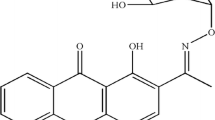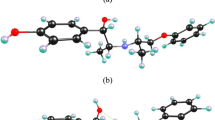Abstract
This study was designed to examine the interaction of 4′-O-(a-L-Cladinosyl) daunorubicin (DNR–D5), a disaccharide anthracycline with calf thymus deoxyribonucleic acid (ctDNA) by UV/Vis in combination with fluorescence spectroscopy and molecular modeling techniques under physiological conditions (Britton–Robinson buffer solutions, pH = 7.4). By the analysis of UV/Vis spectrum, it was observed that upon binding to ctDNA the anthraquinone chromophore of DNR–D5 could slide into the base pairs. Moreover, the large binding constant indicated DNR–D5 had a high affinity with ctDNA. At the same time, fluorescence spectra suggested that the quenching mechanism of the interaction of DNR–D5 to ctDNA was a static quenching type. The binding constants between DNR–D5 and ctDNA were calculated based on fluorescence quenching data at different temperatures. The negative ∆G implied that the binding process was spontaneous, and negative ∆H and negative ΔS suggested that hydrogen bonding force most likely played a major role in the binding of DNR–D5 to ctDNA. Moreover, the results obtained from molecular docking corroborate the experimental results obtained from spectroscopic investigations.






Similar content being viewed by others
References
Yang X, Wang AHJ (1999) Structural studies of atom-specific anticancer drugs acting on DNA. Pharmacol Therapeut 83:181–215
Chaires JB (2006) A thermodynamic signature for drug-DNA binding mode. Arch Biochem Biophys 453:26–31
Beraldo H, Garnier-Suillerot A, Tosi L, Lavelles F (1985) Iron(III)-adriamycin and Iron(III)-daunorubicin complexes: physicochemical characteristics, interaction with DNA, and antitumor activity. Biochemistry 24:284–289
Pang JY, Qin Y, Chen WH, Luo GA, Jiang ZH (2005) Synthesis and DNA-binding affinities of monomodified berberines. Bioorgan Med Chem 13:5835–5840
Singh MP, Joseph T, Kumar S, Bathini Y, Lown JW (1992) Synthesis and sequence-specific DNA binding of a topoisomerase inhibitory analog of Hoechst 33258 designed for altered base and sequence recognition. Chem Res Toxicol 5:597–607
Andrew WHJ, Giovanni U, Gary JQ, Alexander R (1987) Interactions between an anthracycline antibiotic and DNA: molecular structure of daunomycin complexed to d(CpGpTpApCpG) at 1.2 Å resolution. Biochemistry 26:1152–1163
Laurie LP, Fiona MA, Caroline O, Hare C, Stephen ML, John PB, David JR, John AH (2005) Synthesis of novel DNA cross-linking antitumour agents based on polyazamacrocycles. Bioorgan Med Chem 13:2389–2395
Rajender AK, Rajasekhar DR, Reddy MK, Balakishan G, Shaik TB, Chourasia M, Narahari Sastry G (2009) Remarkable enhancement in the DNA-binding ability of C2-fluoro substituted pyrrolo[2, 1-c][1, 4]benzodiazepines and their anticancer potential. Bioorgan Med Chem 17:1557–1572
Ivandini TA, Honda K, Rao TN, Fujishima A, Einaga Y (2007) Simultaneous detection of purine and pyrimidine at highly boron-doped diamond electrodes by using liquid chromatography. Talanta 71:648–665
Zunino F, Di Marco A, Zaccara A, Gambetta RA (1980) The interaction of daunorubicin and doxorubicin with DNA and chromatin. Biochim Biophys Acta 607:206–214
Li JF, Dong C (2009) Study on the interaction of morphine chloride with deoxyribonucleic acid by fluorescence method. Spectrochim Acta Part A 71:1938–1943
Takahara PM, Rosenzweig AC, Frederick CA, Lippard SJ (1995) Crystal structure of double-stranded DNA containing the major addtict of the anticancer drug cisplatin. Nature 377:649–652
Zhou BB, Elledge SJ (2000) The DNA damage response: putting checkpoints in perspective. Nature 408:433–439
Chifotides HT, Dunbar KR (2005) Interactions of Metal–Metal-Bonded Antitumor Active Complexes with DNA Fragments and DNA. Acc Chem Res 38:146–156
Waring M (1970) Validation of the supercoils in closed circular DNA by binding of antibiotics and drugs: evidence for molecular models involving intercalation. J Mol Biol 54:247–279
Chaires JB (2006) A thermodynamic signature for drug-DNA binding mode. Arch Biochem Biophys 453:26–31
Weiss RB, Sarosy G, Clagett-Carr K, Russo M (1986) Anthracycline analogs: the past, present, and future. Cancer Chemoth Pharm 18:185–197
Htun MT (2009) Photophysical study on Daunorubicin by fluorescence spectroscopy. J Lumin 129:344–348
Wang AHJ (1992) Intercalative drug binding to DNA. Curr Opin Struct Biol 2:361–368
Arcamone F (1981) In doxorubicin, anticancer antibiotics in medicinal chemistry series. Academic, New York
Zagotto G, Gatto B, Moro S, Sissi C, Palumbo M (2001) Anthracyclines: recent developments in their separation and quantitation. J Chromatogr B 764:161–171
Cui FL, Qin LX, Zhang GS, Liu QF, Yao XJ, Lei BL (2008) Interaction of anthracycline disaccharide with human serum albumin: investigation by fluorescence spectroscopic technique and modeling studies. J Pharm Biomed Anal 48:1029–1036
Fang LY, Zhang GS, Li CL, Zheng XC, Zhu LZ, Xiao JJ, Gergely S, Janos N, Chan KK, Wang PG, Sun DX (2006) Discovery of Daunorubicin analogue that exhibits potent antitumor activity and overcomes p-gp-mediated drug resistance. J Med Chem 49:932–941
Zhang GS, Fang LY, Zhu LZ, Aimiuwu JE, Shen J, Muller MT, Lee GE, Sun DX, Wang PG (2005) Syntheses and biological activities of disaccharide daunorubicins. J Med Chem 48:5269–5278
Robert FB, Zhong YQ, Fang LY, Seth G, Jie S, Janos N, Zhang GS, Sun DX (2007) Modifying the sugar moieties of Daunorubicin overcomes p-gp-mediated multidrug resistance. Mol Pharm 4:140–153
Fukuda R, Takenaka S, Takagi M (1990) Metal ion assisted DNA-intercalation of crown ether-linked acridine derivatives. J Chem Soc Chem Commun 1028–1030
Kapuscinski J, Darzynkiewicz Z (1985) Interactions of antitumor agents Ametantrone and Mitoxantrone (Novatrone) with double-stranded DNA. Biochem Pharmacol 34:4203–4213
Dang XJ, Nie MY, Tong J, Li HL (1998) Inclusion of the parent molecules of some drugs with beta-cyclodextrin studied by electrochemical and spectrometric method. J Electroanal Chem 448:61–67
Li N, Ma Y, Yang C, Guo L, Yang XR (2005) Interaction of anticancer drug mitoxantrone with DNA analyzed by electrochemical and spectroscopic methods. Biophys Chem 116:199–205
Purcell M, Neault JF, Riahi T (2000) Interaction of taxol with human serum albumin. Biochim Biophys Acta 1478:61–68
Ibrahim MS (2001) Voltammetric studies of the interaction of nogalamycin antitumor drug with DNA. Anal Chim Acta 443:63–72
Bera R, Sahoo BK, Ghosh KS, Dasgupta S (2008) Studies on the interaction of isoxazolcurcumin with calf thymus DNA. Int J Biol Macromol 42:14–21
Ashoka S, Seetharamappa J, Kandagal PB, Shaikh SMT (2006) Investigation of the interaction between trazodone hydrochloride and bovine serum albumin. J Lumin 121:179–186
Lakowicz JR (1999) Principles of fluorescence spectroscopy. Plenum, New York
Lakowicz JR, Weber G (1973) Quenching of fluorescence by oxygen Probe for structural fluctuations in macromolecules. Biochemistry 12:4161–4170
Ware WR (1962) Oxygen quenching of fluorescence in solution: an experimental study of the diffusion process. J Phys Chem 66:455–458
Yue YY, Zhang YH, Zhou L, Qin J, Chen XG (2008) In vitro study on the binding of herbicide glyphosate to human serum albumin by optical spectroscopy and molecular modeling. J Photochem Photobiol B 90:26–32
Cui FL, Qin LX, Zhang GS, Yao XJ, Du J (2008) Binding of daunorubicin to human serum albumin using molecular modeling and its analytical application. Int J Biol Macromol 42:221–228
Bi SY, Song DQ, Tian Y, Zhou X, Liu ZY, Zhang HQ (2005) Molecular spectroscopic study on the interaction of tetracyclines with serum albumins. Spectrochim Acta Part A 61:629–636
Juziro N, Noriko M (1985) Binding parameters of theophylline and aminophylline to bovine serum albumin. Chem Pharm Bull 33:2522–2524
Neméthy G, Scheraga HA (1962) Structure of water and hydrophobic in proteins. J Phys Chem 66:1773–1789
Ross PD, Subramanian S (1981) Thermodynamics of protein association reactions:forces contributing to stability. Biochemistry 20:3096–3102
Takenaka S, Ihara T, Takagi M (1990) Bis-9-acridinyl derivative containing a viologen linker chain: electrochemically active intercalator for reversible labelling of DNA. J Chem Soc Chem Commun 1485–1487
Xu Y, Jing Y, Cai H, Fang YZ (2004) Electrochemical impedance detection of DNA hybridization based on the formation of M-DNA on polypyrrole/carbon nanotube modified electrode. Anal Chim Acta 516:19–27
Tan J, Wang BC, Zhu LC (2009) DNA binding cytotoxicity apoptotic inducing activity, and molecular modeling study of quercetin zinc(II) complex. Bioorgan Med Chem 17:614–620
Acknowledgements
The authors are grateful to the National Natural Science Foundation of China (Grant no. 20673034 and 20672031), the Research Fund for the Doctoral Program of Higher Education of China (Grant no. 20060476001) and the program for Innovative Research Team in University of Henan Province (2008IRTSTHN002) for their financial supports.
Author information
Authors and Affiliations
Corresponding author
Rights and permissions
About this article
Cite this article
Lu, Y., Wang, GK., Lv, J. et al. Study on the Interaction of an Anthracycline Disaccharide with DNA by Spectroscopic Techniques and Molecular Modeling. J Fluoresc 21, 409–414 (2011). https://doi.org/10.1007/s10895-010-0729-7
Received:
Accepted:
Published:
Issue Date:
DOI: https://doi.org/10.1007/s10895-010-0729-7




